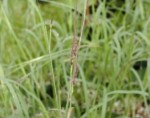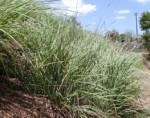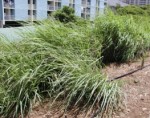Scientific Name: Heterogpogon contortus
Description: Pili grass forms bunches or tufts of light blueish-green leaf blades which range in height from two to three ft. tall. Their flowers, although insignificant in appearance, form spikelets at the top of the plant and often become tangled amongst each other. This dense cluster of seeds is most likely how the plant received its name since the word pili means to stick or cling to.
Distribution: Pili grass is an indigenous plant, or perhaps even a Polynesian introduction that is found in dry open areas, rocky cliffs or slopes near the ocean. It is found throughout the tropics as well as all of the main Hawaiian islands in scattered population. An interesting side note is that many of the Great Plains States utilize pili for in their restorations of grasslands and prairies. Its is probably safe to say that there is more pili grass growing out in those state’s than there is growing here in Hawai’i .
Cultural Uses: Pili was used in the past primarily for thatching houses and can still be used today for that purpose. It was also placed on hula altars for Laka in hopes that newly gained knowledge would pili, or stick in their minds.
Landscape Use and Care: Full sun in hot, dry areas are the best growing conditions for this plant. Pili is very easy to take care of and requires very little watering if any at all. Few pests bother this plant, although it is known that birds often prune off blades for nesting material. Right now pili grass is available at my nursery, Hui Ku Maoli Ola in Kane’ohe for only $2.50 each. I even have a large planting of it on a hill side to control erosion, at which it does an excellent job that people can view to see how it looks fully grown in.
Additional Info: This is probably what the “Little Grass Shack” in Kealakekua, Hawaii was made of. It should also be the material used in building the “Love Shack” since the word pili also means together, to be with, adhere to, join, etc… which are words often associated with lovers. The phrase pili aloha means close friend or beloved companion, so rather than giving your significant other a dozen roses, give her/him a bunch of pili grass to show how much you care. Just make sure you explain the meaning behind it.
Pili









